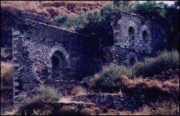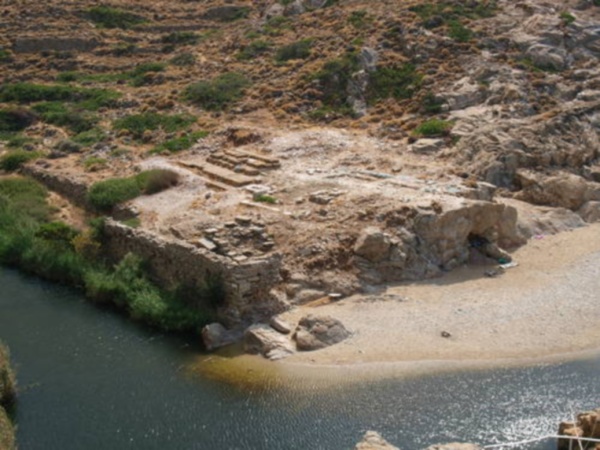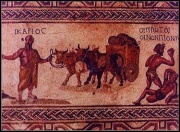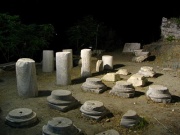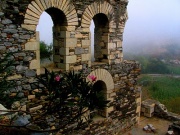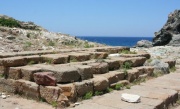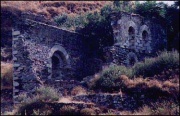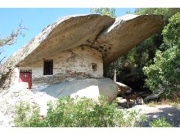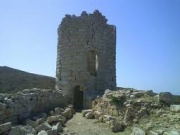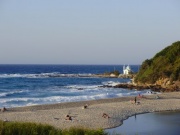Ikaria
ICARIA island
Icarus in classical antiquity, is a member of the Anatolian Sporades, and is part of the same mountain range which connected Samos to Asia Minor. Icaria has nearly an unbroken coastline,and is without adequate ports. The sea around Icaria, the Icarian Pelagos, was known to Homer (Iliad 2. 145) as one of the most turbulent areas of the Aegean. The Icarian Sea is especially tempestuous in July and August during the meltimi season because the island, situated without a protective barrier to the north, has no buffer from these northeasterly gales known as Etesian in antiquity.
There are some neolithic remains on Icaria, that are presently being excavated by a native, Themistocles Katsaros. Another native, the eminent anthropologist Ares Poulianos, has found a number of neolithic artifacts. Until their work is published we can say little about the neolithic period in Icaria except that the island was inhabited in the seventh millennium B.C. The Greeks called these early inhabitants of the Aegean Pelasgians, and they probably controlled Icaria until the second millennium B.C. when the Carians, another indigenous Aegean people, got a foothold in Icaria. These terms, Pelasgians and Carians, are very vague and it is perhaps best to simply think of the early settlers of Icaria as pre-Greek.
The Greeks entered the Aegean in ca. 1500 B.C., and by 1200 B.C. had taken most of the Aegean islands, though there is no sign of any Greek settlement on Icaria until much later. The Greeks may have been discouraged by the lack of harbors, the shortage of arable land, and thick forests. Greeks from Miletus colonized Icaria in ca. 750 B.C, probably establishing a settlement at Therma then Oenoe (modern day Campos.) The purpose of these Milesian outposts on Icaria were probably to aid Milesian ships on their way north to Milesian colonies in the Propontis.
The sources for the history of ancient Icaria consist of random references in ancient authors such as Thucydides, Herodotus, Strabo, Pausanias, Athenaeus, Pliny, and a handful of inscriptions. Eparchides, a native of Oenoe, wrote a history of Icaria about 350 B.C. We assume that he provided a capsule history of the island, but the main purpose of his work seems to have been to promote Icarian wine. Only several fragments of Eparchides' history survive. Accounts by 17h. to 19th travellers are very helpful, especially the book of the Bishop J. Georgirenes in the early 17th. century and the German archeologist L. Ross in the middle of the 19th century.
Sometime in the sixth century B.C. the Icaria was absorbed by Samos and became part of Polycrates sea empire. It was perhaps at this time that the temple of Artemis at Nas, on the northeast corner of the island was built. It seems that Nas was a sacred spot to the pre-Greek inhabitants of the Aegean, and an important port in the Aegean, the last stop before testing the dangerous Icarian Pelasgian. It was an appropriate place for sailors to make sacrifices to Artemis, who among other functions, was a patron of seafarers. The temple stood in good repair until the middle of the 19th. century when it was pillaged by the villagers of Christos, Raches for marble for their local church. In 1939 it was excavated by the Greek archeologist Leon Politis. During the German and Italian occupation of Icaria in the Second World War many of the artifacts unearthed by Politis disappeared. Local custom has it that there are still marble statues embedded in the sand off the coast.
In the first decades of the fifth century Icaria may have fallen into the sphere of Persia. In 490 B.C. the Persian expeditionary force to Greece touched upon Icarian shores. After the war Icaria became part of the Delian League, and prospered. Oenoe became known for its excellent Pramnian Wine. There were several areas in Greece which produced this type of wine, and we do not exactly know what its qualities were, though it seems to have been rather expensive and enabled Oenoe to pay a substantial tribute to the Athenians. The record of this tribute is the aparachai, the tribute list kept in Athens, which shows Oenoe paying 8,000 drachmae in 453, dropping to 6,000 in 449 B.C., and 4,000 in 448 B.C. Therma, which was less prosperous, never paid over 3,000 drachmae. A drachma was a substantial sum in the ancient world,and the total Icarian tax placed Icaria in the upper thirty percent of the tribute paying states.It is not clear why the tax of Oenoe fell by fifty percent in the 440's B.C., but we can guess that the Athenians placed a military colony, a cleruchy, at Oenoe to keep watch on Samos which had rebelled from the Athenian empire. The great playwright Euripides visited the island. His trip may have been officially connected to the Athenian settlement.
Therma, apparently did not share in the great wine industry, and apparently had little to do with Oenoe. There are no records that the two Icarian cities had much contact. This division is reflected in the modern period when in 1912 the two sections of the island almost went to war with one another to determine the site of the capital. Therma's prosperity seems to have been based on its thermal springs which even then were considered highly beneficial.
We can estimate about 13,000 inhabitants on Icaria in the fifth century B.C. The prosperity, which the island enjoyed during the Athenian empire, began to decline during the Peloponnesian War (431 B.c. to 404 B.C.) On two occasions Spartan admirals, Alcidas and Mindarus, brought their fleets to Icaria. After the war Icaria suffered from piratical raids. Conditions improved in 387 B.C. when Icaria, that is Oenoe and Therma, became a member of the Second Athenian League.
Alexander the Great named an island, Failaka, in the Persian gulf Icaria because it resembled Icaria. In fact, there is no resemblance between the two islands, and it is unknown why Alexander would do this, but his gesture does signify that he held Icaria in some degree of esteem, and perhaps had soldiers from the island in his Persian campaign. In the wars that followed the death of Alexander in 323 B.C. Icaria became an important military base. One of Alexander's successors, possibly Demetrius Poliorcetes, built the tower at Fanari, Dracanum, and the adjacent fortress. It is one of the best preserved Hellenistic military towers in the Aegean.
In the second century B.C. the Icarians changed the name of Therma to Aslcepieis. The change in names only lasted for about thirty years. Apparently, it was an effort to advertise the medicinal qualities of the thermal baths and make Therma into an important resort. But this was generally a period of decline. Philip V (221-178) ravaged the Aegean islands. Though the Romans established control of the area they did not adequately patrol the seas. In 129 B.c. Samos was incorporated into the Roman province of Asia, which represented a coastal area of Asia Minor, and Icaria seems to have been included in this province. A Roman general undertook to repair the temple of Artemis which had apparently fallen into a state of disrepair during the third century B.C, doubtless from piratical raids, but the Romans, preoccupied by domestic problems, neglected the Aegean, and by the early years of the first century B.C. pirates took control of the Aegean islands.
All the coastal settlements in Icaria disappeared, and the few people who remained on the island retreated into the interior. The Emperor Augustus (29 B.C.-A.D.14) reestablished order in the Aegean, and encouraged Samians to develop Icaria. The traveller Strabo, ca. 10 B.C., saw two small settlements on Icaria, but noted that it was essentially a deserted island used mainly by Samian ranchers who kept herds of animals there. In the first century A.D. Pliny the Younger was weatherbound on the island for several days and was struckby its rustic qualities.
By the end of the fifth century A.D. Icaria fell into the sphere of the Byzantine Empire. Campos became the administrative center and the seat of a bishopric. The Samians, given support by the government in Constantinople, maintained a local fleet which offered Icaria some protection from pirates.In 1081 A.D. the emperor Alexus Comnenus established, only a few miles from Icaria, the monastery of St. John the Theologian in Patmos. This became a cultural center in the Aegean, and kept Icaria from sliding into total oblivion.
By the end of the 12th. century the Byzantine empire cut back its naval defense and the Aegean became open to inroads from pirates and Italian adventures. The Icarians built fortresses at Paliokastro and Koskino. A glimpse of conditions is provided by a document in the monastery of Patmos which recorded pirates fleeing Patmos and arriving in Icaria where the local population executed them.
In the 14th. century the Genoese took Chios, and Icaria became part of a Genoese Aegean empire. When the Turks drove the Genoese from the Aegean the Knights of St. John, who had their base in Rhodes, exerted some control over Icaria until 1521 when the Sultan incorporated Icaria into his realm. The Icarians killed the first Turkish tax collector, but somehow managed to escape punishment.
The Turks imposed a very loose administration not sending any officials to Icaria for several centuries. The best account we have of the island during these years is from the pen of the bishop J. Georgirnees who in 1677 described the island with 1,000 inhabitants who were the poorest people in the Aegean. In 1827 Icaria broke away from the Ottoman Empire, but was forced to accept Turkish rule a few years later, and remained part of the Ottoman empire until July 17, 1912 when it expelled a small Turkish garrison during the IKARIAN INDEPENDENCE. Due to the Balkan Wars Icaria was unable to join Greece until November of that year. The five months of independence were difficult years. The natives lacked food stuffs, were without regular transportation and postage service, and were on the verge of becoming part of the Italian Aegean empire.
There was considerable dissatisfaction with the Greek government which invested little in developing Icaria which remained one of the most backward regions of Greece. Until the 1960's the Icarians looked to the Icarians in America rather than Athens for help in building roads, schools and medical facilities. Throughout the first half of the 20th. century the economy depended on remittances sent from America by Icarian immigrants who began settling in America in the 1890's.In America Icarians demonstrated a talent as steel mill workers, and independent business men.
TEMPLE OF ARTEMIS AT NAS -"TAVROPOLIO" The sixth century BC temple of Artemis at Nas was built by the Ikarians to honor the mother goddess Artemis, patroness of sailors and protector of hunters and wild animals. Nas was probably the first settled area of Ikaria and throughout antiquity its safe anchorage was an important staging point for sea traffic sailing to Asia Minor. Around 1830 local Ikarian villagers melted down most of the temple's stone blocks in order to build a church. Legend has it that the ancient temple's statue of Artemis is buried somewhere in the river. Snorkelling just off the coast one can see the massive columns of the temple. The pier of the ancient port and the floor of the sanctuary still survive as does the beautiful setting of Tavropolio was the shrine of Artemis who among other names was also called Tavropolos, goddess of the bull or Tavrovolos. The temple of Tavropolio must have been a late Minoan structure as the goddess was worshipped in the late Minoan period. The "Xsoanan" a carved wooden cult image of the goddess which is said to have been discovered by favor of the heavens proves that the shrine was one of the most ancient temples dedicated to the goddess Artemis.Ikaria was one of the first stops of Artemis from Asia Minor and Tavropolio a shrine celebrated throughout Greece. Tavropolio prospered in the years when worship of the goddess was at its peak in the era of Attic civilization. According to the historian Ioannis Melas, Tavropolio was probably not only the temple of the goddess Artemis but also a settlement, one of the four ancient settlements on Ikaria, but no evidence has come to light to prove it. Today at the place of worship where magnificent religious rights were once performed, only ruins survive, parts of the floor and columns of the ancient temple. The whole area is studded with remnants of worn awat marbles. The remains of an old lime kiln reveal that in the early 19 Century the structures of Tavropolio were melted down to obtain building materials for the erection of churches.
DRAKANO This is the ruin of the Ancient City of Drakanos, considered to have been the home of Dionysus. It is located in the Fanari area near the capital, at the easternmost point of the island. A castle still survives on an elevation, the tower of Drakano, a circular structure of the Alexandrine period, 4th century BC.
THERMA The ruined walls of Roman baths situated at Ancient Therma are all that remain of the once prosperous Ikarian city that thrived as a result of the visitors who came to bath in its therapeutic hot mineral springs. Ancient Therma ceased to exist after a devastating earthquake hit the city circa 205 BC. Via snorkeling one can still see the underwater remains of the city where it slid into the sea just offshore from the Roman baths.
OINOE Ancient capital of the island, also called Dionysias. Remnants of the wall that surrounded the town still survive, as well as a ruined dwelling of the Byzantine period. The findings are exhibited at the Kampos Museum.
KOSKINAS CASTLE This is a Byzantine fort dating the 10th Century AD, located near the village of Kozikia in the northern part of the island. Within the fort is the church of Agios Georgios Dorganas
Also information:
http://en.wikipedia.org/wiki/Icaria
http://www.island-ikaria.com/culture/museumKampos.asp
http://www.archipelago.gr/index.php?page=the-ancient-ranti-forest
http://www.nytimes.com/2012/10/28/magazine/the-island-where-people-forget-to-die.html?pagewanted=all
http://www.island-ikaria.com/nature/springs.asp
